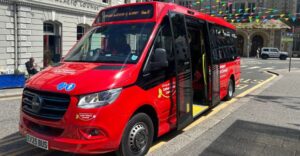UK fails to meet commitment to having six or more rapid or ultra-rapid electric vehicle (EV) chargers at every motorway service area in England by the end of 2023
According to a survey by the RAC using data from Zapmap, just 39% of motorway services in the UK (that is, 46 out of 119 of them) meet the government’s own target for numbers of chargepoints that charge at above 50kW.
This is a considerable issue given that there are thought to be some 1m battery-powered EVs on our roads as of the end of 2023.
The six-or-more target was set in March 2023 in the government’s electric vehicle infrastructure strategy, with the stated aim of giving EV drivers confidence in being able to undertake longer journeys. The intention was to accelerate rollout of high-powered EV chargers on the strategic road network via the £950m Rapid Charging Fund.
But political priorities then seemed to change. In September, Prime Minister Rishi Sunak announced that the ban on new sales of petrol and diesel cars will be extended from 2030 to 2035 – seen by many as a lack of commitment to the transition to EVs more generally. Indeed, it’s been found that increased sales of SUVs are undermining efforts to decarbonise transport. For all the promises of additional rapid charging capacity at motorway services, it wasn’t until December 2023 that the government announced £70m in grants for a pilot scheme comprising upgrades to just 10 services.
That said, there has certainly been some progress in this area. At the end of April 2023, rapid chargers were available at only 27 motorway services – 23% of them. Since then, a further 178 high-powered chargers have been installed, so there are now more than 400 ultra-rapid chargers at services. That means a little over half of services (55%) can offer such charging speeds to drivers.
Some 14 motorway services in England now have more than 12 such devices, up from six in the spring of 2023. The Moto-run services on the M5 near Exeter offers 24 high-powered chargers.
On the other hand, 18 services offer no rapid charging above 50kW and four services have no EV charging facilities at all. Those are: Leicester Forest on both sides of the M1, Barton Park on the A1(M) and Tebay South on the M6.
Zapmap’s statistics show that, as of November 2023, the UK has 53,029 EV charging devices in total; a fifth of these – 19% or 9,992 – are rapid or ultra-rapid. That means just 6% of high-powered chargers (581) are to be found at motorway services.
The government continues to say that it expects there to be some a minimum of 300,000 public-use EV chargers by 2030 and 6,000 high-powered chargers along strategic roads by 2035. There’s clearly a long way to go to achieve this – and some commentators suggest that this ambitious target won’t be enough. For example, the Competition and Markets Authority suggested in ‘Building a comprehensive and competitive electric vehicle charging sector that works for all drivers’ that between 280,000 and 480,000 public chargepoints will be needed by 2030.
A Department for Transport spokesperson told BBC News that, ‘The number of public charge points is surging across the country and around 96% of motorway services now offer charging facilities for drivers. As well as our £70m pilot to help roll out ultra-rapid charge points on motorways, we are driving forward the biggest reforms to our electricity grid since the 1950s – halving the time it takes to build networks and speeding up connections.’
Yet Simon Williams, RAC EV spokesperson, says: ‘It’s clear from our research that the government has fallen well short of its target of having six high-powered chargers at every motorway service area in England. While that’s the case, some very good progress has been made since the end of April when we last carried out our survey, with four-in-10 services (39%) now having met or exceeded the target number of chargers, compared to just under a quarter (23%) eight months ago.
‘There is undoubtedly an eagerness among charge point companies and motorway service operators to install these types of units but unfortunately, it’s often the high-power cabling to the grid that’s the major barrier which is out of their hands.
‘More clearly needs to be done to make this process simpler than it is currently. Hopefully once the government’s Rapid Charging Fund kicks fully into action some of these hurdles will be overcome. We continue to believe that the wide availability of ultra-rapid charging is crucial in giving both current and future EV drivers confidence to know they can easily make journeys beyond the range of their vehicles in a time-efficient way.’
In related news:
















Leave a Reply